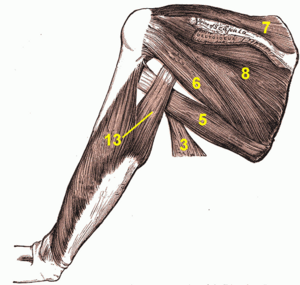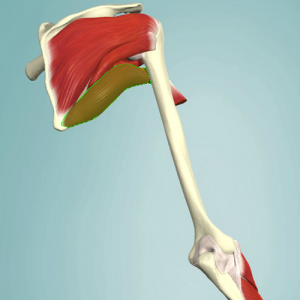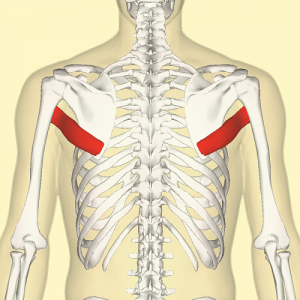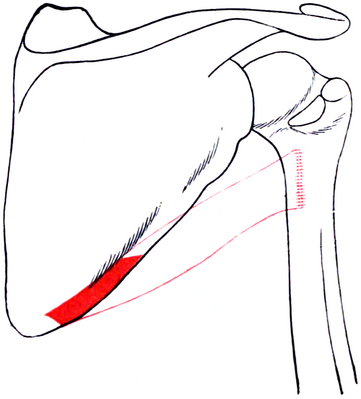Teres Major: Difference between revisions
No edit summary |
No edit summary |
||
| Line 7: | Line 7: | ||
[[File:Teres major.png|right|frameless]] | [[File:Teres major.png|right|frameless]] | ||
Teres major is a small muscle that runs along the lateral border of the scapula. It is one of the seven scapulohumeral muscles that act around the glenohumeral joint to facilitate shoulder movement<ref name=":0">Radiopedia [https://radiopaedia.org/articles/teres-major-muscle Teres Major] Available: https://radiopaedia.org/articles/teres-major-muscle<nowiki/>(accessed 13.1.2022)</ref>.<ref name="gustrength">http://www.gustrength.com/muscles:teres-major-location-actions-and-trigger-points</ref> It's sometimes called "lat's little helper" because of its synergistic action with the latissimus dorsi.<ref name="Biel" /> | Teres major is a small muscle that runs along the lateral border of the scapula. It is one of the seven scapulohumeral muscles that act around the glenohumeral joint to facilitate shoulder movement<ref name=":0">Radiopedia [https://radiopaedia.org/articles/teres-major-muscle Teres Major] Available: https://radiopaedia.org/articles/teres-major-muscle<nowiki/>(accessed 13.1.2022)</ref>.<ref name="gustrength">http://www.gustrength.com/muscles:teres-major-location-actions-and-trigger-points</ref> It's sometimes called "lat's little helper" because of its synergistic action with the latissimus dorsi.<ref name="Biel">Biel A (2005). [https://booksofdiscovery.com/for-instructors/trail-guide-to-the-body/#TGBNEW Trail Guide to the Body] (2nd ed). Boulder, CO: Books of Discovery.</ref> | ||
Image 1: Posterior aspect shoulder - 5 teres major; 3 latissimus dorsi; 6 teres minor; 7 supraspinatus; 8 infraspinatus; 13 triceps brachii long head. | Image 1: Posterior aspect shoulder - 5 teres major; 3 latissimus dorsi; 6 teres minor; 7 supraspinatus; 8 infraspinatus; 13 triceps brachii long head. | ||
| Line 34: | Line 34: | ||
This 2.23 minute video is on Teres Major{{#ev:youtube|1Z-A-Cqsw54}} | This 2.23 minute video is on Teres Major{{#ev:youtube|1Z-A-Cqsw54}} | ||
== Physiotherapy == | == Physiotherapy == | ||
Teres Major | Teres Major injury can happen due to various conditions such as: | ||
Teres major tear | * Teres major tear: common in sports with frequent shoulder movements: pitching in baseball, rowing, swimming, rock climbing, tennis, golf and water skiing. The main symptom of a teres major tear is a sudden sharp pain in the shoulder, upper arm and armpit. The area near the bottom of the scapula can become swollen.<ref name=":1" /> | ||
* Teres Major Strain often occurs when proper warm up is not done before workouts. This is less painful than a tear of the muscle and can subside with time and rest<ref>Prime health channel Teres Major Available:https://www.primehealthchannel.com/teres-major.html (accessed 13.1.2022)</ref>. | |||
==== Presentation ==== | |||
Teres Major helps in most functions involving backward arm movement, an injury to the muscle has been found to produce the following symptoms | |||
* Pain is quite common. This usually arises if the muscle is not given rest and no treatment is carried out. The pain is usually dull and intensifies with physical activity eg hand behind back activities such as reaching in back pocket; downward stoke of freestyle, pitching in baseball, during tennis. | |||
* Inflammation in the affected muscle region. The swelling is not externally visible but can be felt on touching the area. | |||
* Discomfort and pain in upper arm reduces the range of motion of the arm in sufferers. | |||
==== Palpation==== | |||
*With the patient in prone and arm off the side of the table, grasp latissimus dorsi between your fingers and thumb | *With the patient in prone and arm off the side of the table, grasp latissimus dorsi between your fingers and thumb | ||
*Move your fingers and thumb medially to the lateral boarder of the scapula | *Move your fingers and thumb medially to the lateral boarder of the scapula | ||
*Teres major muscle fibers lie medial to the latissimus and attach to the lateral boarder of the scapula | *Teres major muscle fibers lie medial to the latissimus and attach to the lateral boarder of the scapula | ||
*Follow these fibers up towards the axilla where they blend with latissimus dorsi | *Follow these fibers up towards the axilla where they blend with latissimus dorsi<ref name="Biel" /> | ||
=== Length Tension Testing / Stretching<ref>Sanzo P, MacHutchon M (2015). Length Tension Testing Book 2, Upper Quadrant: A Workbook of Manual Therapy Techniques (2nd ed). Canada: Brush Education.</ref>=== | === Length Tension Testing / Stretching<ref>Sanzo P, MacHutchon M (2015). Length Tension Testing Book 2, Upper Quadrant: A Workbook of Manual Therapy Techniques (2nd ed). Canada: Brush Education.</ref>=== | ||
| Line 54: | Line 60: | ||
*Both the moving hand and the hand stabilizing the scapula are used to sense the amount of muscle tension and barrier | *Both the moving hand and the hand stabilizing the scapula are used to sense the amount of muscle tension and barrier | ||
== Treatment == | |||
[[Image:Teres maj trp referral.png|281x281px|alt=|right]]Most cases of Teres Major Injury heal successfully without surgery. Treatment includes | |||
Trigger Point | # POLICE method | ||
# Warm up: Teres Major injuries resulting from workouts are usually cured with proper warm-up before exercising. Warm up helps loosen the muscles and tissues and makes them less compact. Flexibility of the muscles helps them stretch and operate more easily. | |||
TrPs in teres major muscle typically refer pain into the posterior deltoid region and over the long head of the triceps brachii, as well as into the posterior shoulder joint, occasionally into the dorsal aspect of the forearm, and rarely into the scapula or elbow.<ref name="Travell" /> | # Strengthening exercises: Teres Major exercises play a vital role in treatment (see [[Load Management|load management]]). Internal Shoulder Workout is one of the best Teres Major exercises used to strengthen this muscle. If overhead range of motion is limited, avoid vertical push exercises like the overhead press. Do high-incline push exercises instead (e.g. shoulder press on 60-75° incline) | ||
# Stretches eg Side reach lat stretch; Kneeling lat stretch (arms on floor or arms elevated); Overhead lat stretch. | |||
# Posture: Avoidance of slouching over and internally rotating your shoulders. eg when sitting down for long periods, get up for a quick break at least every half hour to split up the time spent in that posture. Walk around or stretch out your teres major. | |||
# Trigger Point Realease: TrPs in teres major muscle typically refer pain into the posterior deltoid region and over the long head of the triceps brachii, as well as into the posterior shoulder joint, occasionally into the dorsal aspect of the forearm, and rarely into the scapula or elbow.<ref name="Travell" /> | |||
# Myofascial Release Techniques | |||
== References == | == References == | ||
Revision as of 02:33, 13 January 2022
Original Editor - Evan Thomas
Top Contributors - Evan Thomas, Lucinda hampton, Joao Costa, Kim Jackson, WikiSysop, 127.0.0.1, Admin, Oyemi Sillo and Naomi O'Reilly
Introduction[edit | edit source]
Teres major is a small muscle that runs along the lateral border of the scapula. It is one of the seven scapulohumeral muscles that act around the glenohumeral joint to facilitate shoulder movement[1].[2] It's sometimes called "lat's little helper" because of its synergistic action with the latissimus dorsi.[3]
Image 1: Posterior aspect shoulder - 5 teres major; 3 latissimus dorsi; 6 teres minor; 7 supraspinatus; 8 infraspinatus; 13 triceps brachii long head.
| [4] | [5] |
|---|
Anatomy[edit | edit source]
Origin: The dorsal surface of the inferior angle of the scapula
Insertion: The medial lip of the intertubercular groove of the humerus[1].
- It is related to the latissimus dorsi muscle which wraps around the lower border of teres major. The tendon of the teres major lies posterior to the tendon of the latissimus dorsi and there is a bursa between them.
Innervation: lower subscapular nerve (C5, C6)
Arterial supply: thoracodorsal branch of the subscapular artery, posterior circumflex humeral artery
Image 2: Teres major of right side - outline and attachment-areas[1].
Function[edit | edit source]
The teres major (TM) muscle acts as a function as a unit with the latissimus dorsi (LD), where it acts in synergy to extend, adduct and internally rotate the shoulder. eg The TM and LD muscles act in the acceleration and follow through phases of the throwing motion in pitchering in baseball.[6]; assists the latissimus dorsi in eg rock climbing, tennis, wood-chopping, swimming, rowing.[7][8][1]
This 2.23 minute video is on Teres Major
Physiotherapy[edit | edit source]
Teres Major injury can happen due to various conditions such as:
- Teres major tear: common in sports with frequent shoulder movements: pitching in baseball, rowing, swimming, rock climbing, tennis, golf and water skiing. The main symptom of a teres major tear is a sudden sharp pain in the shoulder, upper arm and armpit. The area near the bottom of the scapula can become swollen.[8]
- Teres Major Strain often occurs when proper warm up is not done before workouts. This is less painful than a tear of the muscle and can subside with time and rest[9].
Presentation[edit | edit source]
Teres Major helps in most functions involving backward arm movement, an injury to the muscle has been found to produce the following symptoms
- Pain is quite common. This usually arises if the muscle is not given rest and no treatment is carried out. The pain is usually dull and intensifies with physical activity eg hand behind back activities such as reaching in back pocket; downward stoke of freestyle, pitching in baseball, during tennis.
- Inflammation in the affected muscle region. The swelling is not externally visible but can be felt on touching the area.
- Discomfort and pain in upper arm reduces the range of motion of the arm in sufferers.
Palpation[edit | edit source]
- With the patient in prone and arm off the side of the table, grasp latissimus dorsi between your fingers and thumb
- Move your fingers and thumb medially to the lateral boarder of the scapula
- Teres major muscle fibers lie medial to the latissimus and attach to the lateral boarder of the scapula
- Follow these fibers up towards the axilla where they blend with latissimus dorsi[3]
Length Tension Testing / Stretching[10][edit | edit source]
- With the patient in supine, flex the patient's shoulder to 180deg with one hand by holding on the forearm
- Stabilize the scapula along the lateral boarder with the other hand
- With the hand holding the forearm, externally rotate the arm
- Both the moving hand and the hand stabilizing the scapula are used to sense the amount of muscle tension and barrier
Treatment[edit | edit source]
Most cases of Teres Major Injury heal successfully without surgery. Treatment includes
- POLICE method
- Warm up: Teres Major injuries resulting from workouts are usually cured with proper warm-up before exercising. Warm up helps loosen the muscles and tissues and makes them less compact. Flexibility of the muscles helps them stretch and operate more easily.
- Strengthening exercises: Teres Major exercises play a vital role in treatment (see load management). Internal Shoulder Workout is one of the best Teres Major exercises used to strengthen this muscle. If overhead range of motion is limited, avoid vertical push exercises like the overhead press. Do high-incline push exercises instead (e.g. shoulder press on 60-75° incline)
- Stretches eg Side reach lat stretch; Kneeling lat stretch (arms on floor or arms elevated); Overhead lat stretch.
- Posture: Avoidance of slouching over and internally rotating your shoulders. eg when sitting down for long periods, get up for a quick break at least every half hour to split up the time spent in that posture. Walk around or stretch out your teres major.
- Trigger Point Realease: TrPs in teres major muscle typically refer pain into the posterior deltoid region and over the long head of the triceps brachii, as well as into the posterior shoulder joint, occasionally into the dorsal aspect of the forearm, and rarely into the scapula or elbow.[7]
- Myofascial Release Techniques
References[edit | edit source]
- ↑ 1.0 1.1 1.2 1.3 Radiopedia Teres Major Available: https://radiopaedia.org/articles/teres-major-muscle(accessed 13.1.2022)
- ↑ http://www.gustrength.com/muscles:teres-major-location-actions-and-trigger-points
- ↑ 3.0 3.1 Biel A (2005). Trail Guide to the Body (2nd ed). Boulder, CO: Books of Discovery.
- ↑ http://www.primalonlinelearning.com/cedaandp/muscular_system/muscles_of_the_lower_limb.aspx#bicepsfemoris
- ↑ http://en.wikipedia.org/wiki/Teres_major_muscle
- ↑ Fitzpatrick D, Cagle P, Flatow E. Isolated Teres Major Rupture: A case report with a suggested dedicated imaging protocol and review of the literature. Journal of radiology case reports. 2016 Apr;10(4):31. Available: https://www.ncbi.nlm.nih.gov/pmc/articles/PMC4861626/(accessed 13.1.2022)
- ↑ 7.0 7.1 Travell JG, Simons DG, Simons LS (1998). Travell and Simons' Myofascial Pain and Dysfunction: The Trigger Point Manual, Volume 2: The Upper Half of Body (2nd ed). Baltimore, MD: Williams & Wilkins.
- ↑ 8.0 8.1 Ehealth star Teres Major Muscle Available:https://www.ehealthstar.com/anatomy/teres-major-muscle (accessed 13.1.2022)
- ↑ Prime health channel Teres Major Available:https://www.primehealthchannel.com/teres-major.html (accessed 13.1.2022)
- ↑ Sanzo P, MacHutchon M (2015). Length Tension Testing Book 2, Upper Quadrant: A Workbook of Manual Therapy Techniques (2nd ed). Canada: Brush Education.











